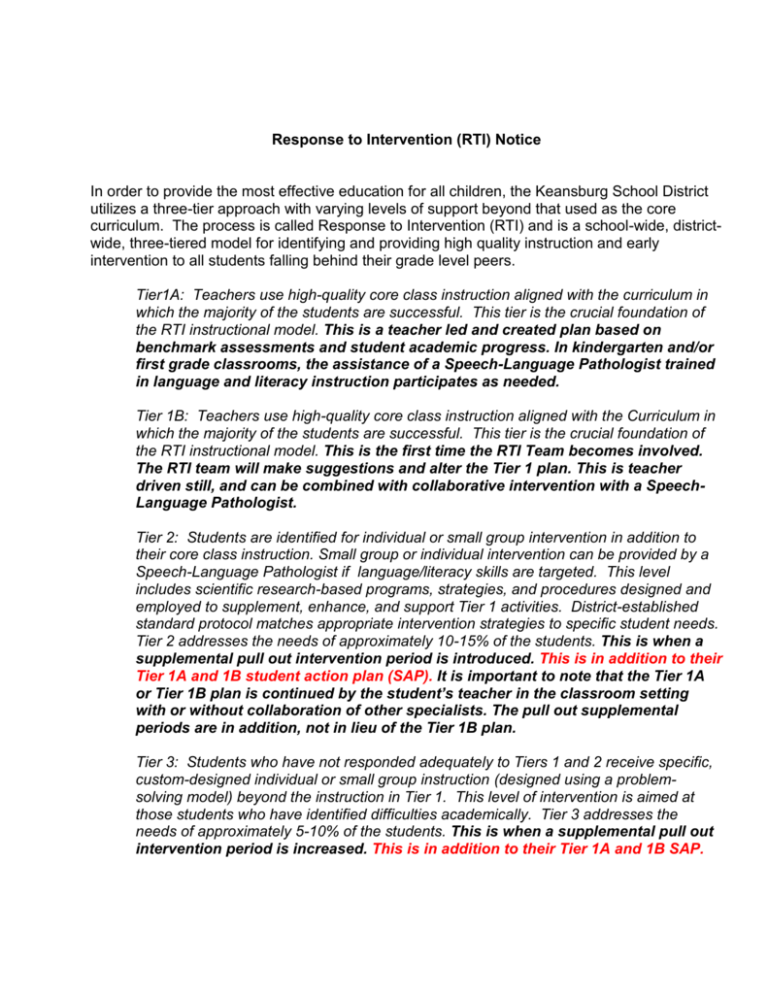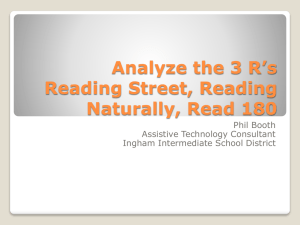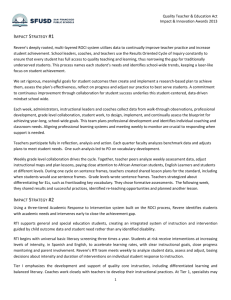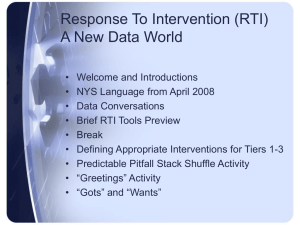RTI Handbook - Keansburg School District / Home
advertisement

Response to Intervention (RTI) Notice In order to provide the most effective education for all children, the Keansburg School District utilizes a three-tier approach with varying levels of support beyond that used as the core curriculum. The process is called Response to Intervention (RTI) and is a school-wide, districtwide, three-tiered model for identifying and providing high quality instruction and early intervention to all students falling behind their grade level peers. Tier1A: Teachers use high-quality core class instruction aligned with the curriculum in which the majority of the students are successful. This tier is the crucial foundation of the RTI instructional model. This is a teacher led and created plan based on benchmark assessments and student academic progress. In kindergarten and/or first grade classrooms, the assistance of a Speech-Language Pathologist trained in language and literacy instruction participates as needed. Tier 1B: Teachers use high-quality core class instruction aligned with the Curriculum in which the majority of the students are successful. This tier is the crucial foundation of the RTI instructional model. This is the first time the RTI Team becomes involved. The RTI team will make suggestions and alter the Tier 1 plan. This is teacher driven still, and can be combined with collaborative intervention with a SpeechLanguage Pathologist. Tier 2: Students are identified for individual or small group intervention in addition to their core class instruction. Small group or individual intervention can be provided by a Speech-Language Pathologist if language/literacy skills are targeted. This level includes scientific research-based programs, strategies, and procedures designed and employed to supplement, enhance, and support Tier 1 activities. District-established standard protocol matches appropriate intervention strategies to specific student needs. Tier 2 addresses the needs of approximately 10-15% of the students. This is when a supplemental pull out intervention period is introduced. This is in addition to their Tier 1A and 1B student action plan (SAP). It is important to note that the Tier 1A or Tier 1B plan is continued by the student’s teacher in the classroom setting with or without collaboration of other specialists. The pull out supplemental periods are in addition, not in lieu of the Tier 1B plan. Tier 3: Students who have not responded adequately to Tiers 1 and 2 receive specific, custom-designed individual or small group instruction (designed using a problemsolving model) beyond the instruction in Tier 1. This level of intervention is aimed at those students who have identified difficulties academically. Tier 3 addresses the needs of approximately 5-10% of the students. This is when a supplemental pull out intervention period is increased. This is in addition to their Tier 1A and 1B SAP. It is important to note that the Tier 1A or Tier 1B plan is continued by the student’s teacher. The pull out supplemental periods are in addition to, not in lieu of the Tier 1B plan. Tier 1A: The teacher identifies any student who has failed the benchmark assessment or is significantly behind his/her peers in academic progress. This is a teacher driven plan meaning that the RTI team is not involved at this point. **** In Kindergarten and/or transitional classes, a UNIVERSAL SCREENING will be conducted by a Speech-Language Pathologist who will identify students with potential skill deficiencies in language and/or literacy. 1. Teacher creates a Student Action Plan (SAP) (F4) based on scientifically proven instructional strategies (appendix A) that address the following: A. Environment B. Instruction C. Assessment ***Add the student to Form 1 (F-1)*** 2. Teacher assesses the student’s progress using formative assessments (see appendix A under Resources for suggestions) as well as benchmark data. 3. After 8 weeks on implementing the SAP and monitoring progress: a. If the student is making progress-continue to implement current SAP. b. If the student continues to struggle academically, refer to RTI team to review Tier 1 SAPs should take the following into consideration when developed: Environment Safe Recognizes and Value Diversity Respectful High Expectation Collaborative Instruction Assessment Starts with differentiating Small Group Instruction Formative Assessment Summative Assessment Modified Instruction Homework/Reinforcement Activities Cooperative Learning Progress Monitoring Informal Quality Feedback that is specific and timely Engages Parents and Community Definitions: Environment: This begins with your expectations of the student (s). In Tier IA and Tier 1B, a student-centered environment will be intentionally designed to support learning for all students. Instruction: In Tier IA and Tier 1B instruction; relevant, rigorous, research based instruction that engages all students in making real world connections in evident. Assessment: Assessment will be frequent, ongoing process analysis to inform instruction. Tier 1B: Student has not made adequate progress in the teacher driven Tier 1A SAP. Referral to RTI Team has been made. This is the first time the RTI Team is involved, however this plan still relies on the general education teacher implementing the SAP. 1. Teacher makes an appointment with building administrator to review the application. 2. Building administrator will review the student’s current SAP, teacher lesson plans, walk through data, student work, and student assessments. If building administrator feels the referral is warranted, the referral will be made to the RTI Team. If the building administrator does not feel a referral is warranted at this time, administrator may make suggestions or changes to the SAP and have the teacher try an additional cycle (8 weeks) If the referral is made to the RTI Team: **If academic concerns include language/literacy skills, the Speech/Language Pathologist will be included as part of the team (K-4). 1. Prior to the meeting, the RTI Facilitator will reach out to the parent and student to conduct interviews and collect data. 2. RTI team will convene to review the artifacts (lesson plans, student work, student assessments, SAP) 3. RTI Team will conduct a root cause analysis to identify specific intervention strategies to use (Learning Intervention Manual should be referenced-located in Principal’s office). 4. A new SAP will be generated by the RTI Facilitator and the student will be added to the RTI Teams log (F7) 5. Team will reconvene at 8 weeks to review the progress made. RTI Team evaluates progress monitoring data and recommends: Return to Tier 1A or 1B (adjust instruction) OR Move to Tier 2 Tier 2: Student has not made adequate progress in the Tier 1B SAP. RTI team moves to Tier 2 1. RTI team will convene to review the artifacts (lesson plans, student work, student assessments, SAP). 2. A new SAP will be generated by the RTI Facilitator and the student will be added to the RTI Teams log (F7) The new SAP will include a Tier 2 pull out component in addition to continuing the Tier 1 strategies. 3. Team will reconvene at 8 weeks to review the progress made. Tier 2 component added to SAP (Tier 1B plan is still utilized; Tier 2 component is in addition): Student receives more intensive, Tier 2, focused intervention in a small group. 1. Additional 60 minutes (maximum) of small group instruction per week (again-in addition to the general education teacher implementing Tier 1B SAP). 2. Highly qualified teacher/Specialist. 3. Pull-out with Specialist. 4. Weekly Progress Monitoring with documentation. 5. Additional 8 weeks of interventions, followed by RTI Team review. Tier 3: Student has not made adequate progress in the Tier 2 SAP. RTI team moves to Tier 3 1. RTI team will convene to review the artifacts (lesson plans, student work, student assessments, SAP). 2. A new SAP will be generated by the RTI Facilitator and the student will be added to the RTI Teams log (F7) The new SAP will include a Tier 3 pull out component in addition to continuing the Tier 1 strategies. 3. Team will reconvene at 8 weeks to review the progress made. Tier 3: (Again-it is important to note that the Tier 1B plan should still be implemented by the general education teacher with the assistance of language/literacy specialists if needed): 1. Student receives more intensive, Tier 3, interventions. 2. Additional minutes (90 minutes above Tier 1B) of small group or one to one instruction. AND/OR 3. Student is recommended for additional evaluation or placement. (This would happen as Tier 3 plan is in place). a. May be referred to Child Study Team b. May be referred for 504 evaluation 4. Progress Monitoring with documentation shall occur weekly or more frequently. 5. Specialist or other highly qualified teacher provides instruction. 6. Student progress continues to be monitored, documented, and reviewed. The student is then placed in appropriate instructional setting. Student Action Plan (SAP) Student Name: Teacher Name: Date of Implementation: Directions: 1. The RTI team will create a plan to help achieve the measurable goal 2. Progress monitoring data will be collected by the assigned person at the determined interval 3. Follow up meeting will be scheduled in intervention results do not reflect targeted growth Area of Concern: Measurable Goal: Tentative date for follow up RTI meeting: Action Plan: What intervention will be used: What is the frequency/intensity/duration: How often will progress monitoring data be collected: What instrument (describe) Who will collect data: Results/Reflection on measurable data collected: Measurement Used: Result Additional Comments/Observations:






